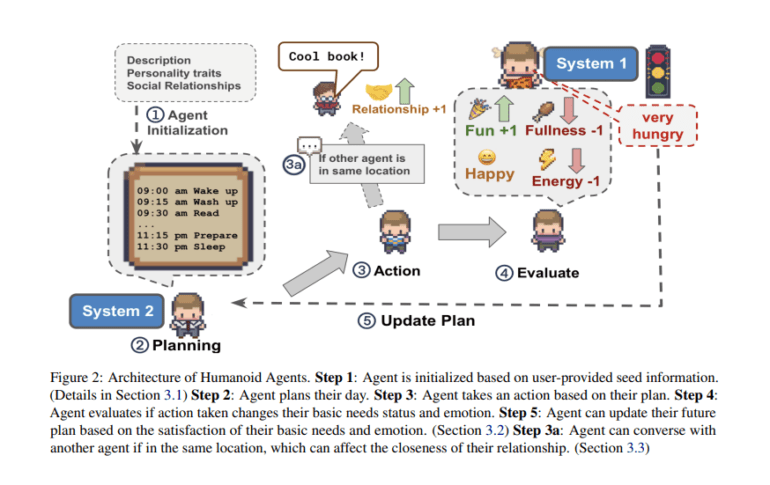TL;DR:
- University of Washington and NVIDIA collaborate to introduce Humanoid Agents.
- Generative agents, powered by AI, aim for human-like interactions.
- Humanoid Agents leverage two-system mechanism inspired by human psychology.
- Agents receive feedback based on social interactions, mirroring human behavior.
- Unity WebGL game interface and Plotly Dash enhance visualization and analytics.
- Humanoid Agents offer the potential for multi-party conversations.
- Ethical considerations remain crucial in the use of human-like generative agents.
Main AI News:
In the realm of artificial intelligence, the quest for human-like interactions has led to significant advancements. Researchers from the University of Washington and NVIDIA have joined forces to introduce a groundbreaking platform known as Humanoid Agents. This innovation promises to revolutionize the world of generative agents, offering a glimpse into a future where AI simulations behave remarkably like humans.
Generative agents, often found in chatbots and virtual assistants, are essential for delivering natural and engaging user experiences. They possess the ability to comprehend user inquiries, engage in meaningful conversations, and execute tasks ranging from answering questions to making personalized recommendations. These agents, powered by natural language processing (NLP) techniques and sophisticated machine learning models like GPT-3, are adept at producing coherent and contextually relevant responses. They seamlessly weave interactive stories, engaging dialogues, and lifelike characters into video games and virtual worlds, elevating the overall gaming experience.
Beyond gaming and user assistance, human-like generative agents hold the potential to unlock a realm of creativity. They become indispensable partners for writers and creatives, facilitating brainstorming sessions, generating intricate story plots, and even composing evocative poetry or music. However, replicating human thought processes is a formidable challenge. Unlike machines, humans possess the remarkable ability to adapt their plans in response to changes in their physical environment.
Enter the Humanoid agents, a brainchild of the collaborative efforts between the University of Washington and the University of Hong Kong. Drawing inspiration from the intricacies of human psychology, these researchers have devised a two-system mechanism. System 1 operates as the intuitive and effortless thinking process, while System 2 handles the logical aspect of cognition. By infusing generative agents with elements like basic needs, emotions, and social closeness, they aim to bridge the gap between AI and human-like behavior.
These designed agents are not isolated entities; they need to interact with others in their simulated environment. Upon failing to do so, they receive feedback in the form of loneliness, sickness, and tiredness. This feedback loop mimics the social brain hypothesis, suggesting that a substantial part of human cognitive abilities evolved to assess the quality of social relationships. Just as humans adapt to changes by interacting with one another, humanoid agents adjust their conversations based on their social proximity. The researchers visualize these agents using a Unity WebGL game interface and provide an interactive analytics dashboard to track the evolving statuses of these simulated entities over time.
To bring their vision to life, the researchers have developed a sandbox HTML game environment powered by the Unity WebGL game engine. Users can immerse themselves in one of three unique worlds, observing the agents’ status and location at each step. The game interface ingeniously transforms JSON-structured files from the simulated worlds into captivating animations. To further enhance the experience, they have engineered Plotly Dash, a tool that offers real-time visualizations of various humanoid agents’ statuses as they evolve.
Currently supporting dialogues between only two agents, these systems are poised to usher in a new era of multi-party conversations. However, it is crucial to recognize that these agents, while astonishing in their capabilities, operate within the realm of simulations. Transparency and ethical considerations must remain paramount, as issues such as misinformation, biases in training data, and responsible usage demand our vigilant attention.
Conclusion:
The introduction of Humanoid Agents represents a significant leap in the world of generative agents, bringing AI simulations closer to human-like interactions. This innovation holds the potential to revolutionize various industries, from gaming to creative content generation. However, as these agents blur the line between AI and human behavior, ethical concerns and responsible usage must remain at the forefront of adoption in the market.

